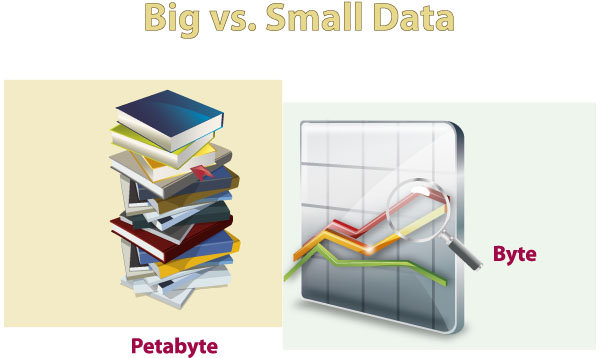The usual trend whenever we speak of Internet of Things (IoT) is to think of Big-Data technologies where huge volumes of data measured in petabytes are stored and subsequently analyzed to draw patterns and trends. But a lot of people ignore that many cases related to IoT only require small chunks of data. What are we referring to when we speak about “Small Data”?
What is “Small Data”?
Small Data are sections of data that are easy to access and can be handled with ease due to their small volume. In fact, they provide us with information without the need to be processed. So, Small Data provides us with clear answers to punctual questions or specific problems.
To mention some examples of Small Data: the result of a football match, stock reports in a particular moment, search results from an Internet engine, weather predictions for a specific day.
Small Data Vs. Big Data
The Small Data concept contrasts with that of the Big Data, as the latter usually refers to a combination of both structured and non-structured data that are measured in petabytes or exabytes. As we said in a previous article, Big Data can be defined by 3 Vs with regard to data: Volume, Variety and Velocity. These 3 Vs make Big Data very complicated to manage. Small Data, on the contrary, is composed of data chunks that are easily handled and can be processed without much trouble.
Small Data Group is a company that researches all the aspects surrounding Small Data. Its founder is Allen Blonde, vice president of Actuate Product Marketing and Innovation. With regard to Small Data, he explains:
Small Data connects people with recent, meaningful and properly structured data, which are easily accessible and can be handled with ease on a day-to-day basis. These data can stem from larger volumes of data or local sources.
Small Data: Cases of Use
A wind turbine contains different sensors whose function is to store and measure relevant attributes for its operation: direction and velocity of the wind, temperature, and vibration. The turbine helix can automatically answer to any variation of the aforementioned attributes, thanks to the information fed by Small Data. Each turbine has capacity to store a Small Data warehouse, which is in turn added up to a larger pool of Big Data, where data processing algorithms can draw trends and behavior patterns. These patterns can reveal information about the performance or state of certain component, based on the maintenance background gathered by Small Data warehouse.
Another example would be the use of intelligent labels in medicinal bottles. Small Data warehouses embedded in the labels can be used to know the exact location of the bottle, the condition of the seal of the bottle, the humidity and temperature around the bottle. Should we wanted to know the exact cause of a particular problem, chunks of Small Data could be added up to larger Big Data volumes to be later on processed on a global scale through analytic algorithms, providing us with an answer that would have taken into account all the variables affecting our particular problem.
Sorting out problems as the ones mentioned above can help save lots of money to both companies and public institutions. Remember: Small Data help us know what is doing a particular object, while Big Data tells us why the object is behaving that way.
